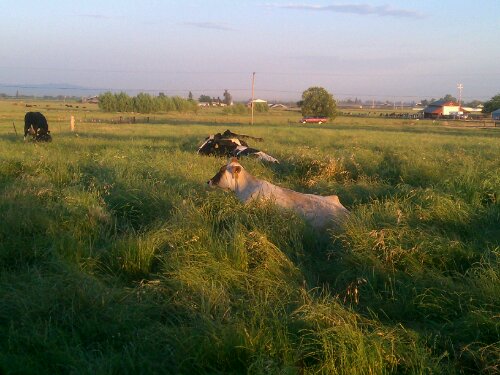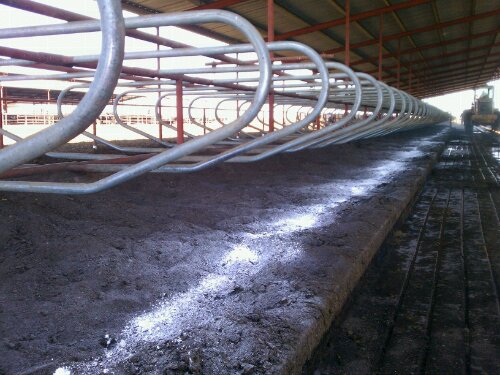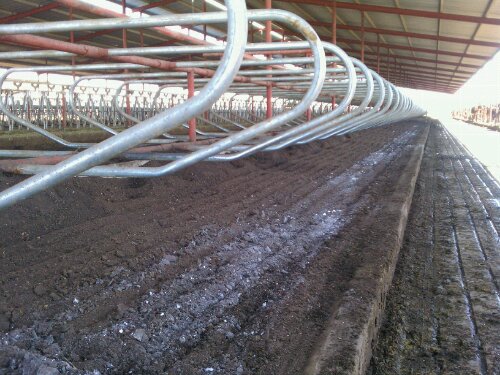Ray-Lin Dairy
farmers
National Cheese Lover’s Day
Hey Cheese Lover’s today is your day so vote for up to 3 of your favorite cheeses below. Feel free to add any not here.
Related articles
- celebrating National Cheese Lover’s Day on January 20 (foodtruckadventure.com)
- Artisanal Cheese Honors “National Cheese Day” With a Facebook Comment Contest to Win Affineur Collection!!! (marcellathecheesemonger.com)
- Cheese lovers. (fitfabflawless.wordpress.com)
- Top 4 Cheese Trends to Enjoy on January 20 – National Cheese Lover’s Day! (foodtruckadventure.com)
Cow Bling!

New calves showing off their bling!
On our farm we use eartags to give each animal an unique identifier that allows us to keep important health records for each animal. Here are a few pictures that show the tags up close.

This is used to apply the tags similar to how ears are pierced for earrings
The tags are applied in a similar fashion to earrings through a soft portion of the ear. Each tag is self contained and is clean and sterile.

Each tag has 2 parts this is the male part

Cow bling has a lot of information about the animal
The information of the tags includes our farm brand (starting at the very top of the biggest tag), next is the unique “840” number assigned to only this animal in the United States, followed by the unique number for our farm, in this case 2129. The small white tag has the same numbers and also id an EID tag that contains an RFID information. We currently do not utilize the RFID tag outside of visual use however are we will be implementing the electronic reading in the future to help with efficiency and to eliminate human error.
Peek a Boo Sun

Beautiful sunrise and one reason we enjoy working with the cows because we can witness natures grandeur first hand.
Awesome sunrise taken from one of our barns.
Just a farmer… Just a person…
Today’s thought: Farmers are people too, we enjoy many of the same hobbies as other’s who walk this great earth. We farmers might be small in numbers however mighty in what we provide as nourishment to this world. Yes farmers are humans first and we are emotionally connected to being the best caretaker’s we can be for our great resources in this world.
Related articles
- Young Farmers & Ranchers-Why We’re Here (farmbureau.wordpress.com)
- Join the Conversation About the Food You Produce (farmbureau.wordpress.com)
Would Old MacDonald be a geek today?
Growing up, most of us sang the classic children’s song “Old McDonald had a farm.” Today’s average farmer is a far cry from what is portrayed by Old MacDonald in that timeless nursery rhyme. Today’s farmer still cares for the animals and soil like Old MacDonald however the way farmers go about that care has changed greatly. Today farmers are more likely to have a smartphone here and tablet there than they would have just a few years ago, a laptop in a tractor or a combine there is a reality too.
Farmers like many others can have a lot on our plates and some farmers even run 24/7 farms so we look for every advantage we can to multitask and manage our time better. At the same time, farmers, by nature, are caring people and technology has allowed us to effectively manage our operations while providing more time to spend with our families and to help our communities than before.
Farming, like many other professions, has ups and downs — weather can cause harvesting or planting issues, things break and prices go up and down. However what makes it all worth it is the time spent with our families and communities that brings us all back around. If through various technological advances we can become better fathers, mothers, sons, daughters, brothers, sisters, cousins, neighbors and friends –it truly makes us better humans.
In the end I think Old MacDonald would be just as big of a geek as Steve Jobs because it would allow him to be a better human being while taking care of the farm too.
Maybe we should consider adding a verse like this:
Old McDonald had a Droid, e-i-e-i-o
And on that Droid he had farm tools, e-i-e-i-o
cow info here, crops info there
Here a cow, here a crop, everywhere a tech tool
Old McDonald had a Droid, e-i-e-i-o
Thanks to Janice Person for the help with the lyrics Image is from Duck Duck Moose Design and the webpage for their Old MacDonald AppLazy Summer Morning
Here is a cow picture for Wordless Wednesday.

A few of our cows enjoying the cool morning before a hot summer day here in Central California.
These cows were just moved into this pasture yesterday and are relaxing in the grass. With all the late rains we had here in the Central Valley and now the heat the grass is growing very quickly in the pasture. these cows need to get up and get to work eating it down!
Posted from WordPress for Android
Related articles
- Cows play in sprinklers? Wordless Wednesday (raylindairy.wordpress.com)
Making the Cow Beds
Here is a look into what goes into providing the cows on our farm clean soft comfortable beds to lie in. The pictures are from start to finish and show how we take solid manure sterilize and dry it, with a process similar to composting, the finished product is essentially soil we then use for bedding. On our farm we use 95% of the solid manure from the cows as bedding as an effort to recycle all we can and leave a minimal environmental footprint.

With use the cows tend to mess up their beds, we keep trying to get them to make their beds but to no avail.

The first thing we do is put down Hydrated Lime to dry out any wet spots, yes cows do occasionally wet the bed.

Next we mix the Lime in with what we call the Freestall Groomer, we use this piece of equipment 3 times a week to re groom the beds.

Here is what the beds look like after being groomed.

The next piece of equipment adds more bedding to the stalls.

This is the finished product a clean soft bed for the cows to lie in.

We use a process similar to composting to dry and sterilize the bedding prior to it's use.
Related articles
- Composted manure is the gardener’s best friend (sfgate.com)
- Hints, Tips and Advice on Using Manure in Your Garden (brighthub.com)
Making Cow Food
A few weeks ago we harvested our winter small grain crop to make it into a fermented cow food called silage. Here are a few pictures of the process.

This is what the crop looks like before harvesting.

This machine is a Windrower it cuts the crop and gathers it into rows to be chopped up by another machine

This machine is a Forage Chopper it picks the rows up and cuts it into approximately inch long pieces then blows it into the truck.

the trucks then back into this machine that packs the pieces of the crop into long plastic tubes.

The crop then ferments inside these airtight tubes and within a few weeks it is cow food.
For more about some of the other things we feed our cows read What Do Cows Eat?
Is going Vegan the answer to farm animal abuse?
NO the answer is to hold animal abusers accountable for their actions and honor those who do the right thing by the animals.
National Dairy FARM is a program created by dairy farmers to set a baseline for animal care and move forward from there, our farm along with many others in the US have embraced this program to help weed out the bad actors.
This afternoon I learned of another undercover video of animal abuse in agriculture and quite honestly I feel let down by fell animal caretakers. I am as horrified as ever that some of the things caught on tape are even happening in agriculture today. There are proper means to euthanize animals to end their suffering, using a hand tool to prolong that suffering is not proper or ethical.
Many farmers like myself and my family spend long hours caring for our animals the proper way only to have one bad actor ruin it for thousands. I personally have given up sleep and meals to make sure the cows came first I know farmers who brave some of the worst weather know to mankind to rescue animals and the thanks we get from another caretaker of animals is a slap in the face. I hope anyone found guilty of any wrongdoing faces the maximum punishment possible.
This is a short post because the more I think about what to write the angrier I get about the whole situation you can read some of my previous thought on animal abuse in some previous posts:
Different undercover footage same reaction from me: OutragePutting the “culture” in Agriculture
I just started reading the recently released book “The Now Revolution” by Jay Baer and Amber Naslund. One of the biggest things to hit me so far is the focus on how customers can use social interactions to get the sense of the “culture” of a business and gain insight into the values a company believes in. Baer and Naslund write “Your company culture consists of two key elements: Your business’ underlying intent and the people you bring together to carry it out.” In other words personal interactions and relationships built with people and faces of the company allow customers the opportunity to learn what the company believes in and it’s core values. Another great point made in the book is : “Having a great product or business to sell is important. But if you truly have something of value to offer, the how and why you go about doing that are every bit as critical as the what.” To further define culture Baer and Naslund explain it consists of 3 parts:
○ Passion
○ Philosophy on how people who interact with the business are treated
○ Actions taken to prove your “culture”
We in agriculture need to work on building relationships with our customers (those buying and using our products) and share our values on “how and why we do what we do” with them. In farming, we may not have a formal customer service department to interact with our loyal customers and as a result they have no understanding of some of today’s innovative farm practices. On the flip side with no clear way to communicate with consumers farmers lose touch of societal shifts in eating habits and changes consumers may be wanting. We are vital pieces of the food chain, however, the only personal interactions our customers have with people in the food chain are with the employees of the supermarkets or restaurants they frequent. Does the supermarket chain and its employees have the same values as farmers? Restaurants? I would hope so however I am not willing to risk my farming future on it. As farmers we need to be cognizant that the majority of our customers learn about farming from driving by our farms as they go about their daily routines and from their interactions at farmers markets. If our customers drive by an unkempt farm what impression are they left with? If the only personal relationship with someone in agriculture is those they meet at farmer’s markets what do they think of the rest of farmers? In agriculture we as farmers care greatly for the environment, animals and our communities, however are we conveying that message through relationships? For more on creating relationships please read Building Bridges, Connecting Communities.
A good friend of mine and fellow Agvocate Chris Chinn asked the question “Who Is Telling the Story of Agriculture?” in a recent blog post. I would like to ask a different but similar question:
“What are you doing to tell the story of agriculture?”
Do you have to tell your story of agriculture online with social platforms like blogs, Twitter and Facebook? No, however you need to tell your story where you are comfortable doing so. Places such as schools, churches, civic groups and supermarkets are great opportunities to interact with others and share your values with them.
Another great way to show that we as farmers care for our communities is to sponsor roadside cleanups or community events. As a group farmers are some of the best stewards of local communities, however do those who live outside the local area see what we do? To bring more awareness to what we as farmers care about we can sponsor events in bigger communities to help others understand the “culture” of agriculture. If there are major roadways near your farm sponsor the cleanup of a section of roadway so the many cars driving by see that farmers care.
In addition to community support and social platforms other great ways to agvocate are speaking to local service and hobby groups like Larkin Martin from Alabama does. Laurie Kyle from Wisconsin uses her background working in a school library and nutrition degree to discuss inaccuracies she sees in articles by writing letters to the editor and adding comments to online articles.
Together we can put the “culture” back in Agriculture and tell the wonderful story farmers and rancher’s have to tell!
For more reading on “culture” here is a blog post I came across after this was originally posted: “Culture Trumps Strategy, Every Time”
- Dairy kids having fun




